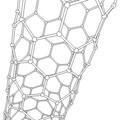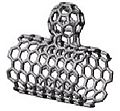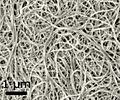Carbon nanotube facts for kids


A carbon nanotube is a tiny, tube-shaped material made only from carbon atoms. Think of it like a super-small, rolled-up sheet of carbon. Carbon nanotubes are incredibly strong and hard to break, yet they are also very light.
These amazing tubes are a special form, or allotrope, of carbon, just like diamonds and graphite are different forms of carbon. Because they are so strong and light, scientists believe carbon nanotubes could be used to make things like super-tough armor or new, lightweight materials for cars and airplanes. Some types of nanotubes can also carry electricity really well. In fact, they can be up to 1,000 times better at conducting electricity than common metals like copper or silver!
Contents
What are Carbon Nanotubes?
Carbon nanotubes are like tiny, hollow cylinders made of carbon atoms. These atoms are arranged in a pattern similar to a honeycomb. Imagine taking a very thin sheet of carbon, called graphene, and rolling it up into a seamless tube. That's basically what a carbon nanotube is! They are incredibly small, often just a few nanometers wide. A nanometer is one billionth of a meter, so these tubes are much, much smaller than a human hair.
How are they Made?
Scientists use special methods to create carbon nanotubes. One common way is called chemical vapor deposition (CVD). In this process, carbon-containing gases are heated to very high temperatures. This causes the carbon atoms to form the tube shapes. Another method involves using an electric arc, where carbon electrodes are zapped with electricity in a controlled environment.
Amazing Properties of Nanotubes
Carbon nanotubes have some truly unique and exciting properties that make them useful for many future technologies.
Super Strong and Light
One of the most impressive things about carbon nanotubes is their strength. They are considered one of the strongest materials known to humankind. They are also incredibly light. This combination of strength and lightness makes them perfect for building materials that need to be tough but not heavy. For example, they could be used to make stronger sports equipment, lighter car parts, or even parts for spacecraft.
Excellent Electrical Conductors
Some carbon nanotubes are fantastic at conducting electricity. This means electricity can flow through them very easily. This property is important for making tiny electronic devices. They could be used in future computer chips, super-fast wires, or even flexible electronic screens. Imagine a phone screen that can bend and fold without breaking!
Good Heat Conductors
Besides electricity, carbon nanotubes can also conduct heat very well. This means they can quickly move heat away from sensitive electronic parts, helping devices stay cool and work better.
Future Uses of Carbon Nanotubes
Because of their amazing properties, carbon nanotubes are being studied for many exciting uses.
Stronger Materials
- Armor: Their incredible strength could lead to new types of bulletproof vests and vehicle armor that are lighter and more effective.
- Sports Gear: Stronger and lighter tennis rackets, bicycles, and other sports equipment.
- Aerospace: Lighter and more durable parts for airplanes and spacecraft, which could save fuel and make space travel easier.
Advanced Electronics
- Tiny Computers: They could be used to make even smaller and faster computer chips.
- Flexible Electronics: Imagine clothes that can monitor your health, or screens that roll up like paper.
- Better Batteries: Nanotubes could help make batteries that charge faster and last longer.
Medical Uses
- Drug Delivery: Scientists are exploring using nanotubes to deliver medicines directly to specific cells in the body, like cancer cells.
- Medical Sensors: They could be used to create very sensitive sensors to detect diseases early.
Images for kids
-
A scanning tunneling microscopy image of a single-walled carbon nanotube
-
A scanning electron microscopy image of carbon nanotube bundles
See also
 In Spanish: Nanotubo de carbono para niños
In Spanish: Nanotubo de carbono para niños










